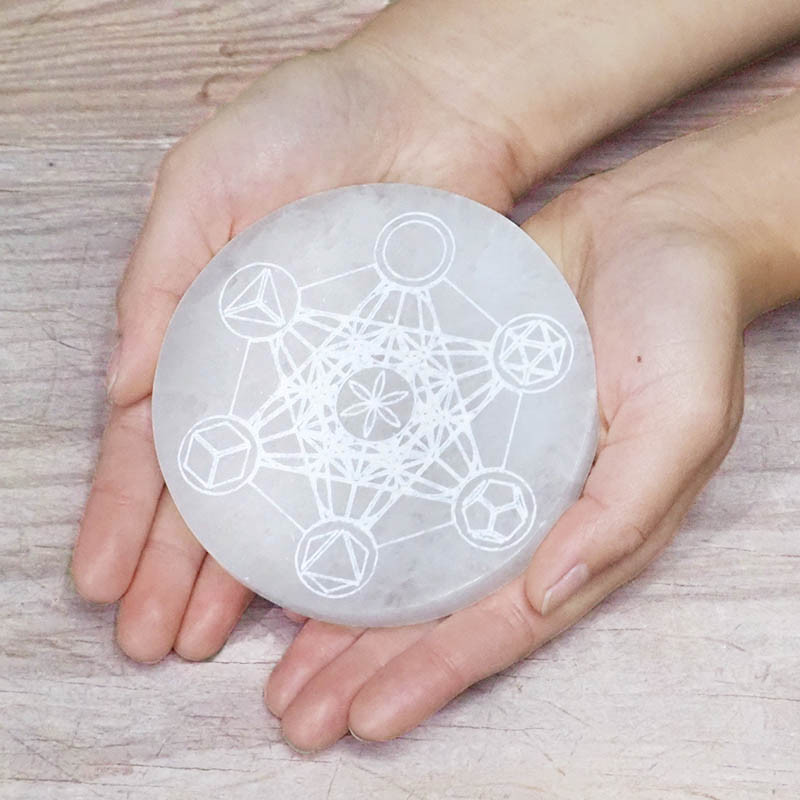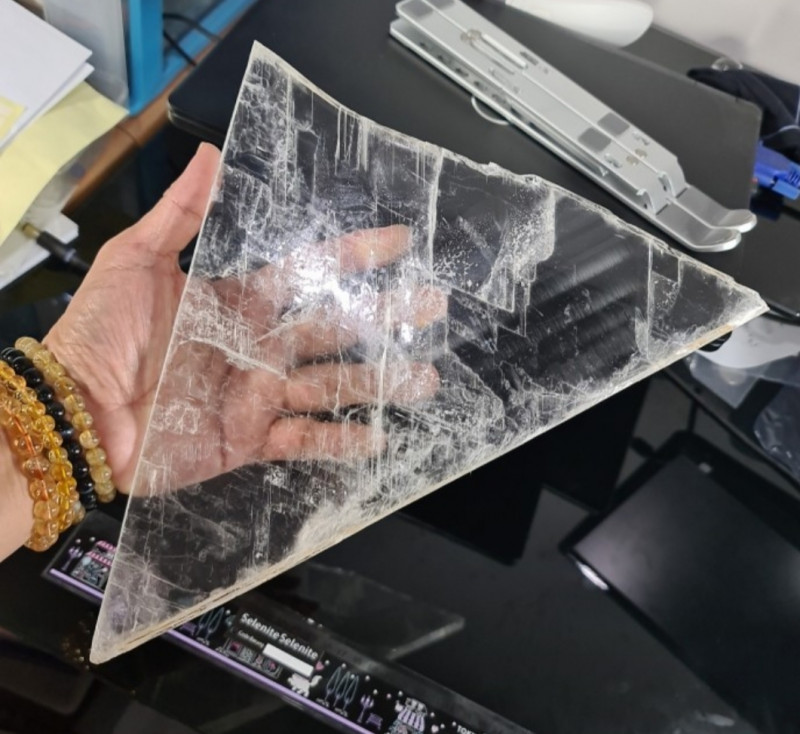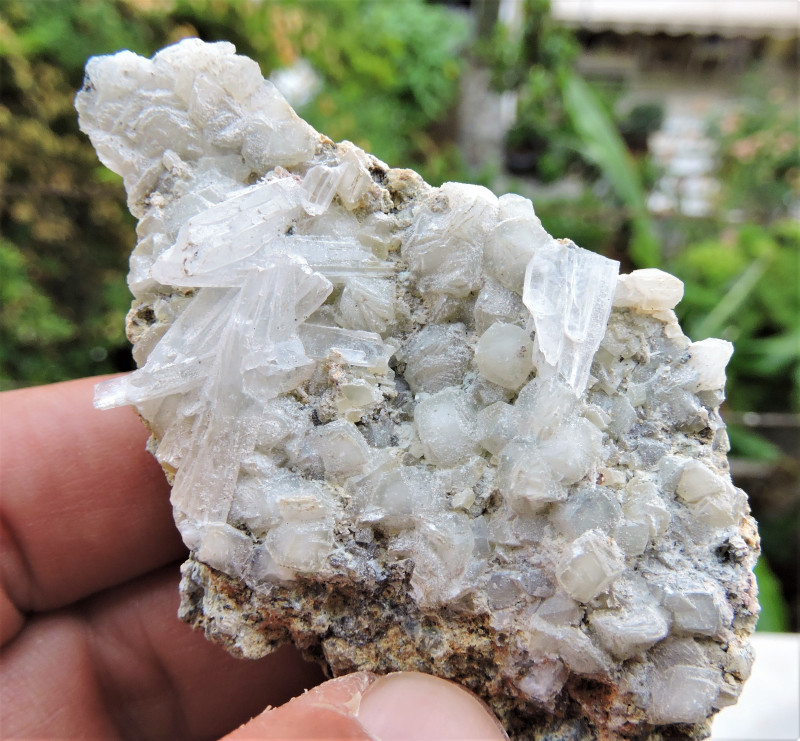
Gypsum Gemstone: Properties, Meanings, Value & Information
 Gypsum gemstones are soft, light-colored sulfates known for forming a variety of mesmerizing crystal shapes and being one of the world’s oldest building materials. In fact, there’s a good chance the walls in your home contain gypsum!
Gypsum gemstones are soft, light-colored sulfates known for forming a variety of mesmerizing crystal shapes and being one of the world’s oldest building materials. In fact, there’s a good chance the walls in your home contain gypsum!
Is gypsum a rock or mineral? Both! That’s right, you can find gypsum mineral crystals and rock masses (called gypsum rock). It’s also the most common natural sulfate mineral.
If you’re familiar with the Mohs mineral hardness scale, you may recognize gypsum as the standard 2-ranking gem. Crystal healing lovers may know gypsum for its popular cleansing variety, selenite.
But there’s so much more that makes gypsum both a unique crystal and an essential part of our modern lives!
By the end of this guide, you’ll know all the gypsum properties and uses, prices, varieties, and more. First, let’s cover gypsum gemstone basics.

What Is Gypsum Stone?
The semi-precious gemstone gypsum is typically a white or grayish-white gemstone, though impurities can make it different colors. The gypsum crystal shapes are similarly diverse, from gorgeous rosettes to massive columns. Some even have “water-like” transparency.
Part of the mineral’s appeal is being readily available, flame-resistant, and non-toxic. With that in mind, what is gypsum stone used for? The most common use is for manufacturing wallboards (drywall) and plaster.
Other non-gemstone uses include:
Cement retardant (controls hardening rate)
Soil conditioner
Food additive & ingredient
Coloring additive for cosmetics and pharmaceuticals
Hair product thickener
Toothpaste binding agent
Metal smelting
Astrologically, gypsum is a zodiac stone for Aries. Plus, any astrology lover will love the array of zodiac wheel gypsum carvings out there!
Gypsum Specifications & Characteristics
The gypsum formula is CaSO4⋅2H2O, or calcium sulfate dihydrate. Its composition is very close to anhydrite (CaSO4), just with water added. However, pure gypsum is extremely rare, so you’ll usually find it mixed with materials like sand, shale, or limestone, to name a few.
You know gypsum hardness ranks at 2 on the Mohs scale, but you may not know that it can also have 1.5-hardness rankings on certain sides of the crystal.
Gypsum is often mistaken for quartz. One good rule of thumb for distinguishing them is temperature. Quartz is cold to the touch, but gypsum is an insulator, so it’s warm. Plus, you can scratch gypsum with your fingernail, but not quartz.
Check out the physical properties of gypsum below:
Mohs hardness: 2; Some directions may be 1.5
Color: Usually colorless, gray, or white; Can be black, yellow, brown, pink, or blue
Crystal structure: Monoclinic
Luster: Waxy, sub-vitreous, vitreous, pearly, or silky; Often pearly on cleavages
Transparency: Transparent to translucent; Some varieties opaque
Refractive index: 1.52-1.53
Density: 2.30-2.33
Cleavage: Perfect in 1-direction; Distinct in 2 directions
Fracture: Granular, conchoidal, or splintery
Streak: White
Luminescence: Often fluorescent; Most often pale blue in SW-UV & pale yellow in LW-UV; Can be yellow-green, green, light pink, white, or yellow in SW-UV & green, pale blue, or orange-yellow in LW-UV; Sometimes phosphorescent
Pleochroism: None
Birefringence: 0.009- 0.010
Dispersion: Strong
That covers the mineral basics, but how many types of gypsum are there?
 Pictured above: Selenite cabochon
Pictured above: Selenite cabochon
Types of Gypsum
Depending on who you ask, there are either three or four types of gypsum. What are the four types of gypsum?
Besides gypsum itself, the other varieties are alabaster, selenite, and satin spar. However, many consider satin spar a type of selenite, which we’ll agree with for this guide. (For more information on satin spar, desert rose, and gypsum flower, visit our selenite info guide).
Now, what sets each gypsum variety apart?
Selenite
Selenite is a colorless to white, transparent variety with large, often flat crystals. These crystals may have coloring from impurities, but most are only surface-level. Gypsum is rarely faceted, but any faceted examples are usually selenite.
Alabaster
Alabaster gypsum is porous, fine-grained, and usually white. It can also be pink, brown, or yellow. This translucent variety can be a gypsum mineral or rock containing gypsum. It’s typically found as massive blocks, which have been a carving material for millennia.
You’ve got the fundamentals down, so let’s move into the spiritual (and historical) side!

Gypsum Crystal Meaning & History
Gypsum symbolizes clarity and transformation. The gypsum crystal spiritual meaning is also one of heavenly protection.
In Old English, gypsum was called spærstān, meaning “spear stone,” after its spear-like pointed crystals. The word “gypsum” comes from the Greek gypsos, meaning “burned” or “calcined.” Gypsos was used as a word for plaster, and gypsum had to be calcined (heated to remove moisture) before being used in plaster.
The earliest evidence currently known of humans using gypsum dates back to 6000 B.C. in Anatolia (mostly modern-day Turkey). Almost all ancient gypsum uses were for carvings, sculptures, or construction. One exception is Native Americans, who created white paint with gypsum.
In 3700 B.C., Egyptians used gypsum for the Great Pyramids, along with other building projects. Gypsum carvings also flourished in Greece, China, and the Middle East.
The name “Plaster of Paris” that's often seen for gypsum came about in the 1600s.
After the tragedy of the London Fire, French King Louis XIV implemented the use of gypsum plaster to prevent fires. This change, along with the significant gypsum deposits in Montmartre, led to the Parisian moniker.
In more modern times, early Hollywood filmmakers took advantage of gypsum’s flaky quality to replicate falling snow, sometimes mixing it with cornflakes. The fire-resistant and non-toxic gypsum properties made it safer than former snow simulants like cotton and asbestos.
Moving from movies to the more mystical, what are the healing properties of gypsum?

Gypsum Healing Properties
All gemstones, including gypsum, can function as distinct healing stones. Like other white crystals, gypsum can facilitate spiritual awakening and higher states of awareness. Likewise, gypsum is also a great chakra stone for the center of spiritual ascension: the crown chakra!
This crystal is essential for any crystal healing kit. Arguably the most popular of selenite gypsum uses is as a tool for cleansing other crystals, but it’s a lucky protection stone.
Physical Healing
Gypsum is said to relieve ailments like joint pain, stomach issues, and headaches. Some also use it for making skin more elastic and youthful.
Traditional Chinese medicine practitioners use the crystal for soothing heat-related conditions like fevers, burns, dehydration, and inflammation.
Emotional Healing
Gypsum crystal benefits those who feel listless or crave more stimulation in life. It’s believed to dispel feelings of lethargy, help you understand what’s holding you back, and encourage new ideas.
Overall, gypsum helps energy flow more effectively, setting the path for you to transform your day-to-day by transforming your perspective.

Gypsum Gemstone Properties
Every gemstone has certain properties that affect its objective value, which is important for helping buyers to shop smarter.
For gemstone jewelry lovers, is gypsum used in jewelry? Rarely. For one, gem-quality crystals are incredibly rare. Additionally, the stone’s softness makes jewelry use difficult. However, there are some workarounds to make gypsum jewelry possible, and decor is an equally beautiful option!
For jewelry or decor, gypsum’s value factors are color, cut, transparency, and treatments.
Color
Gypsum color is almost always pale and may show marble or banding patterns. Inclusions can lead to more eye-catching colors, like the rusty reds, oranges, or yellows caused by iron oxides. Since colorless crystals are most common, brighter hues will often be more valuable.
Cut
Gypsum stones with faceted cuts are virtually nonexistent, though you may see some faceted selenite. You may see raw gypsum specimens or cabochons in earrings or wire-wrapped pendants.
Typically, the alabaster variety is carved into figurines or decor. The softness means you can even use woodworking tools to carve it.
Transparency
Crystals and slabs with higher transparency, particularly any water-like clear specimens, can fetch higher prices than cloudy pieces.
Treatments & Synthetics
Gypsum may be dyed, bleached, heated, or coated to alter its color or increase its durability. Alabaster is usually dyed, as its porosity takes color well. In fact, some treated alabaster is sold as an affordable alternative to marble.
While there aren’t any synthetic gypsums created for gemstone use, the stone may be combined with other materials to imitate more valuable gems like rainbow moonstone.

Gypsum Formation & Sources
Gypsum is an evaporite, meaning a sedimentary mineral formed through water evaporation.
When calcium- and sulfate-rich water evaporates, it leaves behind these elements in sediment, and this process repeats. Over time, pressure and heat turned these sediments into gypsum. Often, limestone dissolves from being exposed to volcanic sulfuric acid, and gypsum is a by-product.
Most gypsum started forming 100-200 million years ago, when the oceans and lakes that covered the Earth started dissipating. You’ll often find gypsum in large, bedded sedimentary deposits that used to be bodies of water.
On that note, where is gypsum found?
Mining Locations
Gypsum has deposits in over 90 countries. Historically, Nova Scotia, Canada, had one of the largest deposits. Today, North America and Spain are notable producers, while Italy and England are significant producers of alabaster. One famous locale is Mexico's gigantic gypsum crystal cave called “Cave of the Crystals.”
You’ll also find gem-quality gypsum in:
Australia
Chile
China
Czech Republic
Egypt
Germany
Peru
Russia
USA (Mostly California, Iowa, Nevada, Oklahoma, and Texas)
Unlike most stones, 80 percent of gypsum sales occur in the same nation that produced the stones. Speaking of sales, are gypsum crystals valuable?

Gypsum Price & Value
Luckily, gypsum is a very affordable gemstone. You can find huge rough specimens, and most rough is under $10. Colored rough may be slightly higher at about $20-$40.
Most gypsum crystals for sale are selenite, which typically ranges overall from $1-$30. The pricier selenites are large, unique crystal specimens like desert rose, which can reach nearly $1,700.
More mainstream items like wands, spheres, or palm stones usually range from $2-$20 depending on size and transparency. Intricate carvings may have higher prices depending on the craftsmanship required.
Gypsum Care and Maintenance
With gypsum’s low hardness and perfect cleavage, careful gemstone care is essential. Some gypsum stones have elastic (bendable) tenacity, but others will break with a hard blow.
Does gypsum dissolve in water? It’s moderately soluble in water, but actually becomes less soluble when it’s hotter. A tiny gypsum crystal will dissolve very slowly while submerged in water that’s being stirred, but won’t dissolve much in boiling water.
To clean gypsum gemstones, very carefully wipe the surface with a slightly damp cloth dipped in pure acetone or alcohol (no water) for a few seconds. Then, gently pat it dry with a clean, dry cloth. Avoid scrubbing. You can also use a can of pressurized air to blow away debris or dust.
Keep your gypsum gemstones away from:
Water, particularly cold water or salt water (stone dissolves)
Heat, including mechanical cleaning systems (stone turns cloudy)
Prolonged sunlight (reduces durability, color, and luster of stone)
Acids, especially hydrochloric acid (stone dissolves)
Soil (stone dissolves)
Store gypsum away from other gemstones in a soft fabric pouch, ideally in a cool and dry place with under 30 percent humidity and 55-72℉ (13-22℃) temperature.

Ready to Grab Hold of Gypsum?
Even though most gypsum is used as a building material — likely including the walls in your own home — its beauty as a gemstone shouldn’t be overlooked.
A gorgeous gypsum crystal or carving in your space will fill both the room and your spirit with warmth, excitement, and divine light.
Seeking a heavenly cleansing crystal? Buy gypsum gemstones today!
Search the Gemstone Encyclopedia
Related Auctions
Related Articles
Originally the Birthstones or gemstones were associated with a zodiac sign or the month of a individuals birth. Find out what your stone is and view the stones we have for sale
8th Feb 2021
There are dozens of quartz and chalcedony gems with various colors and patterns. Learn all about quartz properties and every type of quartz, from amethyst and agate to plasma and phantom quartz!
15th Oct 2020
Hackmanite is a pink to violet sodalite gem known for its unique color-change and luminescence. Learn why hackmanite is special, from its rare qualities to the types of hackmanite jewelry available.
28th Mar 2018
Latest Articles
Yugawaralite is a rare colorless, white, or pinkish zeolite crystal named for its discovery in Yugawara, Japan. Here we uncover the multifaceted history, properties, prices, and uses of yugawaralite.
24th Mar 2025
Simpsonite is a lesser-known mineral known on the gem market for its durability, yellow-orange color, and rarity. Discover all the properties, uses, prices, and history of simpsonite.
3rd Mar 2025
Kurnakovite is a colorless crystal related to inderite and rarely faceted but known among collectors. Explore the mineral traits, history, prices, and more in this kurnakovite guide.
17th Feb 2025
Article Categories
How To's is where you will find helpful articles from gem Rock Auctions on how to cut gemstones, select gemstones and buy gemstones.
9 Articles





